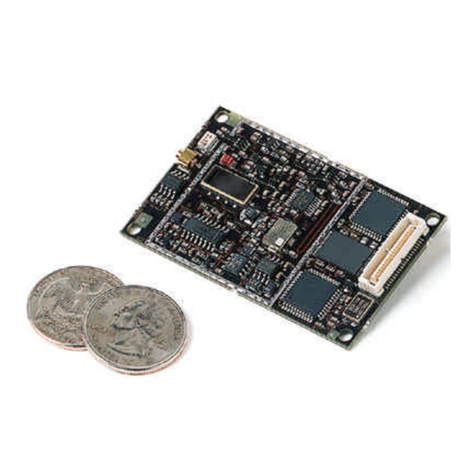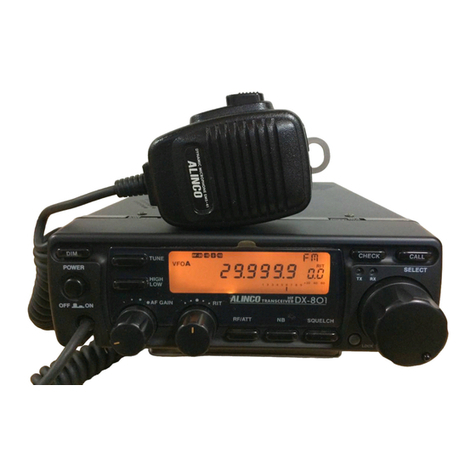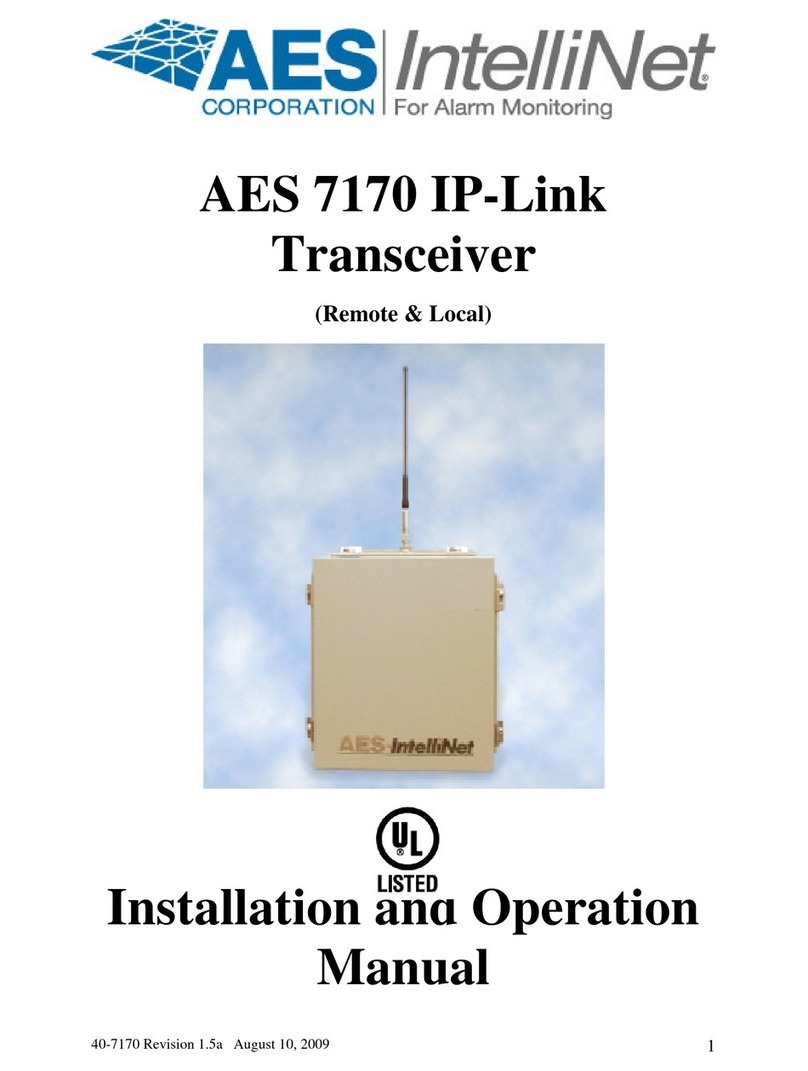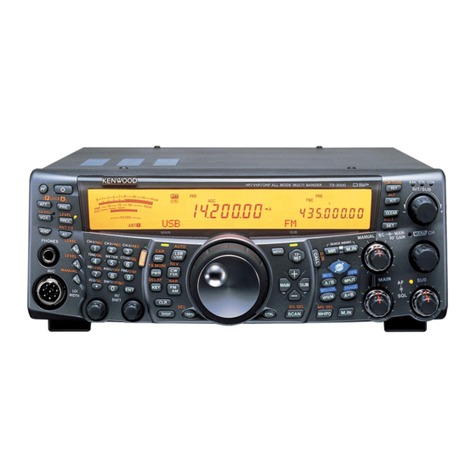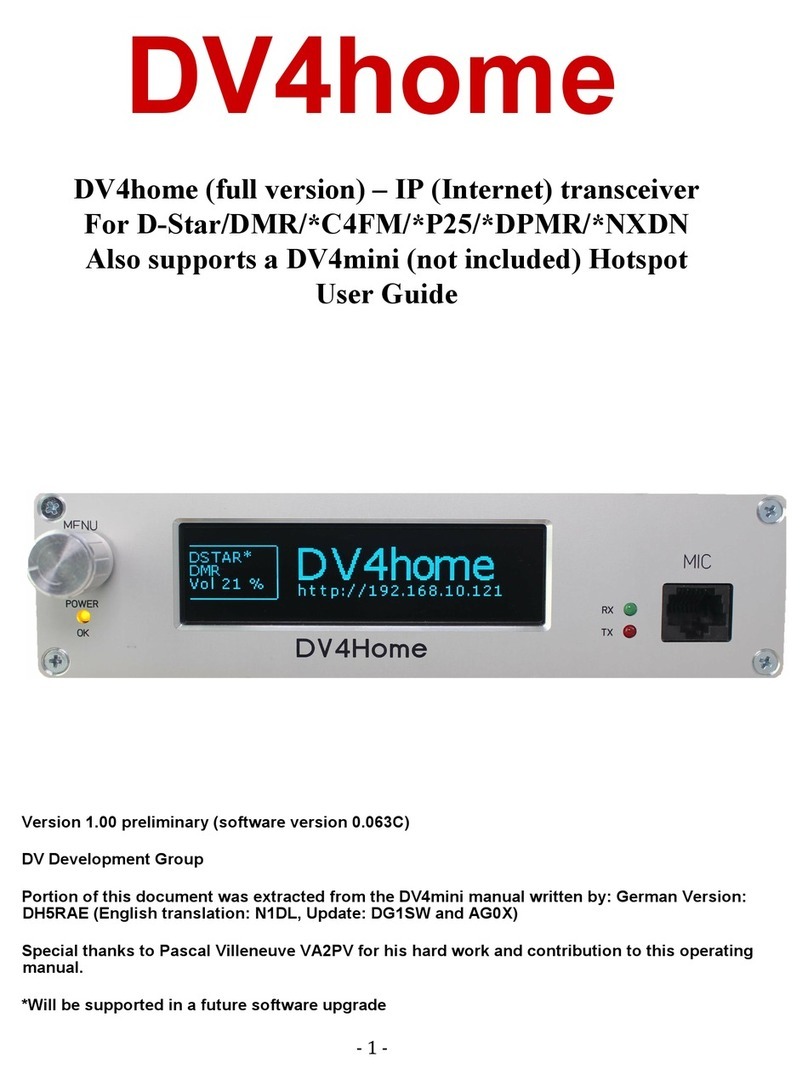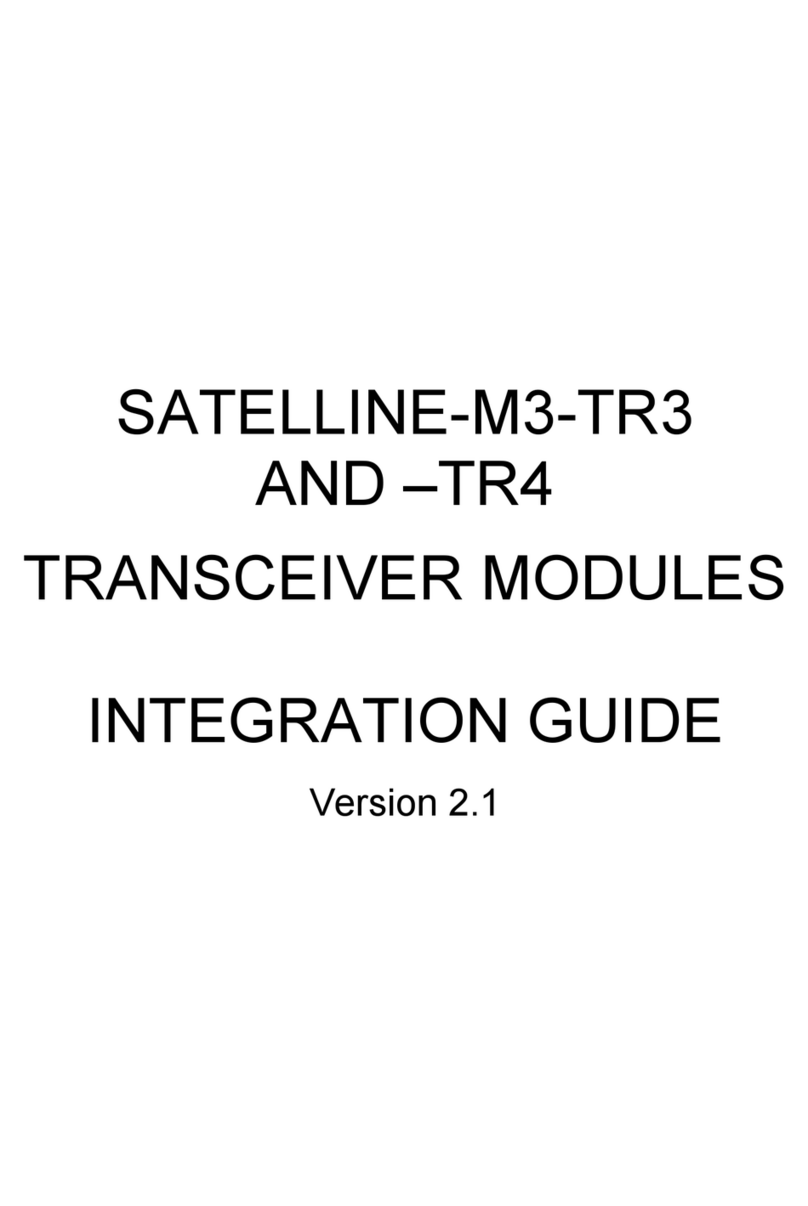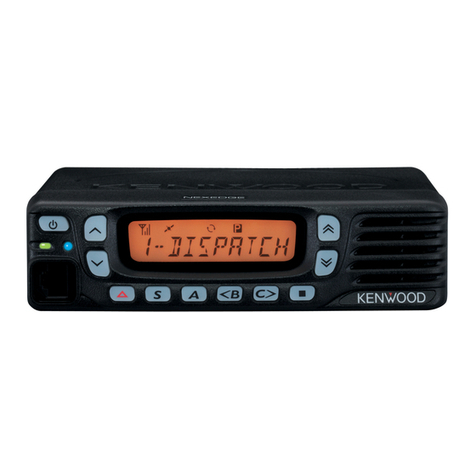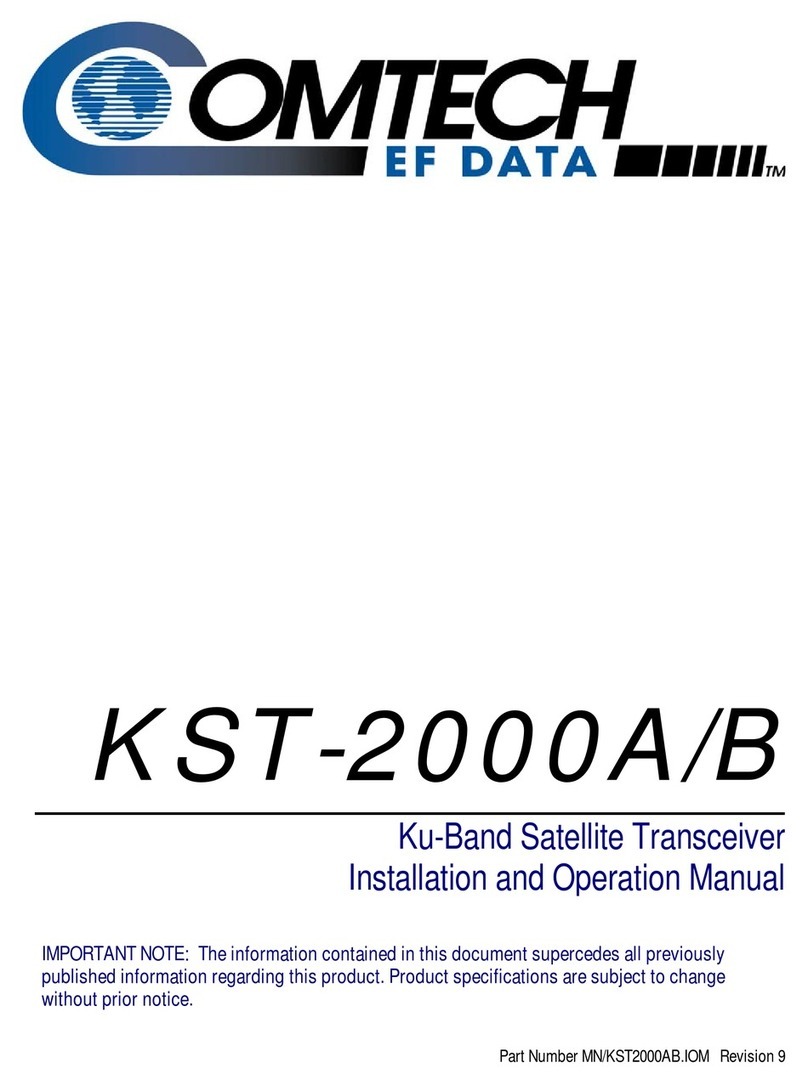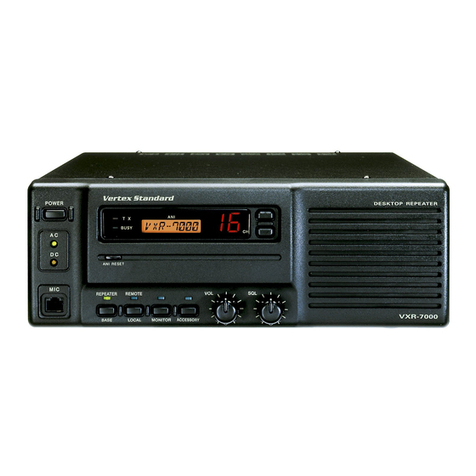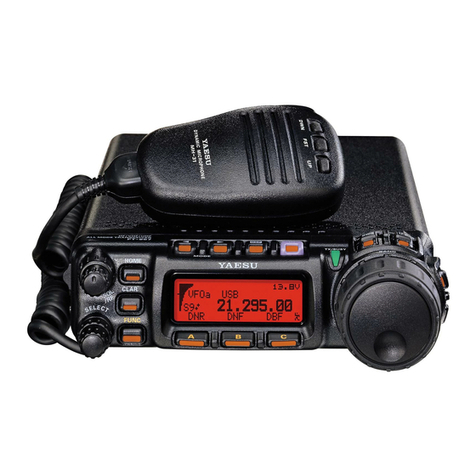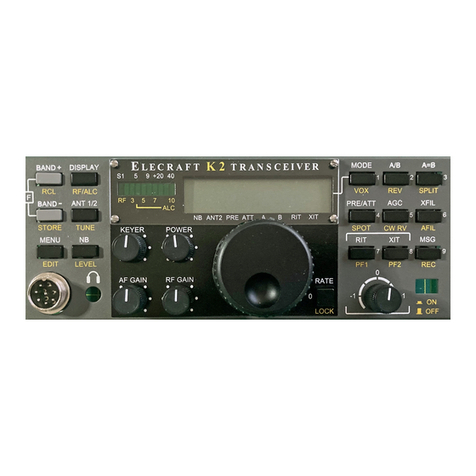AeroComm AC4790 User manual

2
DOCUMENT INFORMATION
Copyright
Information
Copyright © 2006 AEROCOMM, Inc. All rights reserved.
The information contained in this manual and the accompanying software programs are
copyrighted and all rights are reserved by AEROCOMM, Inc. AEROCOMM, Inc. reserves the right
to make periodic modifications of this product without obligation to notify any person or entity
of such revision. Copying, duplicating, selling, or otherwise distributing any part of this
product or accompanying documentation/software without the prior consent of an authorized
representative of AEROCOMM, Inc. is strictly prohibited.
All brands and product names in this publication are registered
trademarks or trademarks of their respective holders.
This material is preliminary
Information furnished by AEROCOMM in this specification is believed to be accurate. Devices sold by AEROCOMM are
covered by the warranty and patent indemnification provisions appearing in its Terms of Sale only. AEROCOMM makes no
warranty, express, statutory, and implied or by description, regarding the information set forth herein. AEROCOMM reserves
the right to change specifications at any time and without notice.
AEROCOMM’s products are intended for use in normal commercial and industrial applications. Applications requiring
unusual environmental requirements such as military, medical life-support or life-sustaining equipment are specifically not
recommended without additional testing for such application.
Limited Warranty, Disclaimer, Limitation of Liability
For a period of one (1) year from the date of purchase by the OEM customer, AeroComm warrants the OEM
transceiver against defects in materials and workmanship. AeroComm will not honor this warranty (and this warranty
will be automatically void) if there has been any (1) tampering, signs of tampering; 2) repair or attempt to repair by
anyone other than an AeroComm authorized technician.
This warranty does not cover and AeroComm will not be liable for, any damage or failure caused by misuse, abuse,
acts of God, accidents, electrical irregularity, or other causes beyond AeroComm’s control, or claim by other than the
original purchaser.
In no event shall AeroComm be responsible or liable for any damages arising: From the use of product; From the
loss of use, revenue or profit of the product; or As a result of any event, circumstance, action, or abuse beyond the
control of AeroComm, whether such damages be direct, indirect, consequential, special or otherwise and whether
such damages are incurred by the person to whom this warranty extends or third party.
If, after inspection, AeroComm determines that there is a defect, AeroComm will repair or replace the OEM
transceiver at their discretion. If the product is replaced, it may be a new or refurbished product.
Downloaded from Elcodis.com electronic components distributor

3
DOCUMENT INFORMATION
Revision Description
Version 1.0 2/21/2005 – Initial Release Version
Version 1.1 3/4/2005 – Updated Session Count Truth Table in Section 4.
Version 1.2 4/26/2005 – Updated Transmit Mode Section.
Version 1.3 3/27/2006 – Corrected API Send Data Complete. Added Australian Channels. Added 1x1
documentation. Added Original Max Power byte (0x8E) and Full Product ID (0x90). Changed Sense
Adjust default to varies. Added Appendix 1 – Power Supply Application Note.
Downloaded from Elcodis.com electronic components distributor

4
TABLE OF CONTENTS
OVERVIEW.......................................................................................................................................................6
SPECIFICATIONS ............................................................................................................................................7
PIN DEFINITIONS ......................................................................................................................................................8
ELECTRICAL SPECIFICATIONS.....................................................................................................................................9
THEORY OF OPERATION..............................................................................................................................10
MASTERLESS ARCHITECTURE...................................................................................................................................10
Modes of Operation..............................................................................................................................10
API Control 12
SERIAL INTERFACE ......................................................................................................................................14
OEM Host Data Rate ............................................................................................................................14
Serial Interface Baud Rate....................................................................................................................14
Flow Control .........................................................................................................................................15
HALF DUPLEX /FULL DUPLEX .................................................................................................................................15
INTERFACE TIMEOUT/RF PACKET SIZE.....................................................................................................................16
SYSTEM TIMING AND LATENCY ................................................................................................................................16
MAXIMUM OVERALL SYSTEM THROUGHPUT ..............................................................................................................16
RANDOM BACK OFF ..............................................................................................................................................17
SYSTEM ID/RF CHANNEL NUMBER .........................................................................................................................17
MAX POWER.........................................................................................................................................................18
HARDWARE INTERFACE...............................................................................................................................20
GIn (Generic Inputs 0 and 1) (pins 4 and 14 respectively) and GOn (Generic Outputs 0 and 1) (pins
1 and 9 respectively) ............................................................................................................................20
TXD (Transmit Data) and RXD (Receive Data) (pins 2 and 3 respectively).........................................20
CTS Handshaking (pin 7) .....................................................................................................................20
RTS Handshaking (pin 8) .....................................................................................................................20
Test (pin 12).........................................................................................................................................20
RSSI (pin 13).........................................................................................................................................21
UP_Reset (pin 15).................................................................................................................................21
Command/Data (pin 17).......................................................................................................................21
AD In (pin 18)........................................................................................................................................21
Session Status (pin 20) ........................................................................................................................21
CONFIGURING THE AC4790.........................................................................................................................22
AC4790 AT COMMANDS .......................................................................................................................................22
Enter AT Command Mode....................................................................................................................23
Exit AT Command Mode ......................................................................................................................23
ON-THE-FLY CONTROL COMMANDS (CC COMMAND MODE)......................................................................................23
COMMAND QUICK REFERENCE ..................................................................................................................24
Firmware Revision Request..................................................................................................................25
Change Channel...................................................................................................................................25
Broadcast Packets................................................................................................................................25
Write Destination Address ....................................................................................................................25
Read Destination Address....................................................................................................................25
Auto Destination ...................................................................................................................................25
Read API Control ..................................................................................................................................25
Write API Control ..................................................................................................................................26
Set Max Power......................................................................................................................................26
Read Temperature................................................................................................................................26
Read Digital Inputs ...............................................................................................................................26
Read Radio Table .................................................................................................................................26
Downloaded from Elcodis.com electronic components distributor

5
Read ADC ..........................................................................................................................................27
Write Digital Outputs.............................................................................................................................27
Probe ..........................................................................................................................................27
EEPROM Byte Read .............................................................................................................................27
EEPROM Byte Write .............................................................................................................................28
Reset Command...................................................................................................................................28
EEPROM PARAMETERS................................................................................................................................29
DIMENSIONS.................................................................................................................................................32
ORDERING INFORMATION ...........................................................................................................................37
PRODUCT PART NUMBER TREE ...............................................................................................................................37
DEVELOPER KIT PART NUMBERS.............................................................................................................................37
AGENCY COMPLIANCY INFORMATION .......................................................................................................38
AC4790-1X1 .......................................................................................................................................................38
AGENCY IDENTIFICATION NUMBERS .........................................................................................................................38
APPROVED ANTENNA LIST ......................................................................................................................................38
FCC /INDUSTRY CANADA (IC) REQUIREMENTS FOR MODULAR APPROVAL...................................................................39
OEM Equipment Labeling Requirements.............................................................................................39
Antenna Requirements.........................................................................................................................39
Warnings Required in OEM Manuals ...................................................................................................39
Warnings Required in OEM Manuals ...................................................................................................40
Channel Warning..................................................................................................................................40
APPENDIX I - POWER SUPPLY APPLICATION NOTE ...................................................................................41
APPENDIX II – CONVERTING FROM 5V LEVELS TO 3.3V LEVELS...............................................................43
APPENDIX III - API .........................................................................................................................................44
APPENDIX IV – API TIMING DIAGRAMS ........................................................................................................47
LIST OF FIGURES
Table 1 - Pin Definitions ......................................................................................................................................8
Table 2 - Input Voltage Characteristics (AC4790-1000 & AC4790-1x1) .............................................................9
Table 3 - Output Voltage Characteristics (All).....................................................................................................9
Table 4 - Session Count Truth Table ................................................................................................................11
Table 5 - Supported Serial Formats..................................................................................................................14
Table 6 - Baud Rate/Interface Timeout ............................................................................................................14
Table 7 - Maximum Overall System Throughput ..............................................................................................16
Table 8 - RF Channel Number Settings ............................................................................................................17
Table 9 - EEPROM Parameters.........................................................................................................................29
Table 10 - Agency Identification Numbers........................................................................................................38
Table 11 - AC4790 Approved Antenna List.......................................................................................................38
LIST OF TABLES
Table 1 - Pin Definitions ......................................................................................................................................8
Table 2 - Input Voltage Characteristics (AC4790-1000 & AC4790-1x1) .............................................................9
Table 3 - Output Voltage Characteristics (All).....................................................................................................9
Table 4 - Session Count Truth Table ................................................................................................................11
Table 5 - Supported Serial Formats..................................................................................................................14
Table 6 - Baud Rate/Interface Timeout ............................................................................................................14
Table 7 - Maximum Overall System Throughput ..............................................................................................16
Table 8 - RF Channel Number Settings ............................................................................................................17
Table 9 - EEPROM Parameters.........................................................................................................................29
Table 10 - Agency Identification Numbers........................................................................................................38
Table 11 - AC4790 Approved Antenna List.......................................................................................................38
Downloaded from Elcodis.com electronic components distributor

6
AC4790 Transceiver Module
The compact AC4790 900MHz transceiver can replace miles of cable in harsh industrial
environments. Using field-proven FHSS technology which needs no additional FCC
licensing in the Americas, OEMs can easily make existing systems wireless with little or no
RF expertise.
AC4790 Features
Networking and Security
Masterless: True peer-to-peer, point-to-multipoint, point-to-point
Retries and Acknowledgements
API Commands to control packet routing and acknowledgement on a packet-by-packet basis
Frequency Hopping Spread Spectrum for security and interference rejection
Customizable RF Channel number and system ID
Dynamic link analysis, remote radio discovery
Software controlled sensitivity
Hardware Protocol Status monitoring
Two generic input and output digital lines and integrated ADC functions
Easy to Use
Continuous 76.8 kbps RF data stream
Software selectable interface baud rates from 1200 bps to 115.2 kbps
Low cost, low power and small size ideal for high volume, portable and battery powered applications
All modules are qualified for Industrial temperatures (-40°C to 80°C)
Advanced configuration available using AT commands
OVERVIEW
The AC4790 is a member of AeroComm’s ConnexRF OEM transceiver family. The AC4790 is a cost effective, high
performance, frequency hopping spread spectrum transceiver; designed for integration into OEM systems operating
under FCC part 15.247 regulations for the 900 MHz ISM band.
AC4790 transceivers operate in a Masterless architecture. The unique feature of this architecture is its dynamic Session
extension and Collision Avoidance mechanism, which uses a proprietary scoring system to promote contention free
communication and ensure that each node has fair access to the network. This instinctive dynamic peer-to-peer
networking architecture enables several transceiver pairs to carry on simultaneous conversations on the same network.
To boost data integrity and security, the AC4790 uses AeroComm’s field-proven FHSS technology featuring optional
Data-Encryption Standards (DES). Fully transparent, these transceivers operate seamlessly in serial cable replacement
applications. Communications include both system and configuration data via an asynchronous TTL or optional RS-485
serial interface for OEM Host communications. Configuration data is stored in an on-board EEPROM and most
parameters can be changed on the fly. All frequency hopping, synchronization, and RF system data
transmission/reception is performed by the transceiver.
This document contains information about the hardware and software interface between an AeroComm AC4790
transceiver and an OEM Host. Information includes the theory of operation, specifications, interface definition,
configuration information and mechanical drawings. The OEM is responsible for ensuring the final product meets all
appropriate regulatory agency requirements listed herein before selling any product.
Note: Unless mentioned specifically by name, the AC4790 modules will be referred to as the “radio” or “transceiver”.
Individual naming is used to differentiate product specific features. The host (PC/Microcontroller/Any device to which the
AC4790 module is connected) will be referred to as “OEM Host”.
Downloaded from Elcodis.com electronic components distributor

7
Specifications
GENERAL
20 Pin Interface Connector Molex 87759-0030, mates with Samtec SMM-110-02-S-D
RF Connector Johnson Components 135-3711-822
Antenna AC4790-1x1: Customer must provide
AC4790-200: MMCX Connector or integral antenna
AC4790-1000: MMCX Connector
Serial Interface Data Rate Baud rates from 1200 bps to 115,200 bps
Power Consumption (typical) Duty Cycle (TX=Transmit; RX=Receive)
10%TX 50%TX 100%TX 100%RX
AC4790-1x1: 33mA 54mA 80mA 28mA
AC4790-200: 38mA 68mA 106mA 30mA
AC4790-1000: 130mA 650mA 1300mA 30mA
Channels 3 Channel Sets comprising 56 total channels
Security One byte System ID. 56-bit DES encryption key.
Interface Buffer Size Input/Output: 256 bytes each
TRANSCEIVER
Frequency Band 902 – 928 MHz
RF Data Rate 76.8 kbps fixed
RF Technology Frequency Hopping Spread Spectrum
Output Power Conducted (no antenna) EIRP (3dBi gain antenna)
AC4790-1x1: 10mW typical 20mW typical
AC4790-200: 100mW typical 200mW typical
AC4790-1000: 743mW typical 1486mW typical
Supply Voltage AC4790-1x1: 3.3V, ±50mV ripple
AC4790-200: 3.3 – 5.5V, ±50mV ripple
AC4790-1000*: Pin 10: 3.3 – 5.5V ±50mV ripple
Pin 11: 3.3 ±3%, ±100mV ripple
* Pins 10 and 11 may be tied together, provided the supply voltage never falls below 3.3 V and is capable of
supplying 1.5 A of current.
Sensitivity -100dBm typical @ 76.8kbps RF Data Rate
Initial Transceiver Sync time/Hop period 25ms / 50 ms
Range, Line of Site (based on 3dBi gain
antenna)
AC4790-1x1: 1 mile
AC4790-200: 4 miles
AC4790-1000: 20 miles
EEPROM write cycles 20000
ENVIRONMENTAL
Temperature (Operating) -40°C to 80°C
Temperature (Storage) -50°C to +85°C
Humidity (non-condensing) 10% to 90%
PHYSICAL
Dimensions Transceiver with MMCX Connector: 1.65” x 1.9” x 0.20”
Transceiver with Integral Antenna: 1.65” x 2.65” x 0.20”
AC4790-1x1: 1.00” x 1.00” x 0.162”
Weight Less than 0.75 ounce
CERTIFICATIONS
AC4790-200 AC4790-1000
FCC Part 15.247 KQLAC4490-100 KQLAC4490
Industry Canada (IC) 2268C-AC4490 2268C-AC44901000
Downloaded from Elcodis.com electronic components distributor

8
PIN DEFINITIONS
The AC4790 has a simple interface that allows OEM Host communications with the transceiver. The table below shows the
connector pin numbers and associated functions. The I/O direction is with respect to the transceiver. All outputs are 3.3VDC levels
and inputs are 5VDC TTL (with the exception of AC4790-1x1 and AC4790-1000 transceivers which have 3.3V inputs). All inputs are
weakly pulled High and may be left floating during normal operation (with the exceptions listed for the AC4790-1x1).
Table 1 - Pin Definitions
Module Pin 1x1 Pin Type Signal Name Function
1 4 O GO0 Session status if Protocol Status is enabled. Otherwise, generic output.
6 O TXD Transmitted data out of the transceiver2
I/O RS485 A (True)1Non-inverted RS-485 representation of serial data
7 I RXD Data input to the transceiver3
I/O RS485 B (Invert) 1 Mirror image of RS-485 A
4 52GI0 Generic Input pin
5 3 GND GND Signal Ground
6 O Do Not Connect Has internal connection, for AeroComm use only.
7 9 O
CTS
Clear to Send – Active Low when the transceiver is ready to accept data for
transmission.
8 102I
RTS
Request to Send – When enabled in EEPROM, the OEM Host can take this High
when it is not ready to accept data from the transceiver. NOTE: Keeping RTS High
for too long can cause data loss.
9 19 O GO1
Received Acknowledge status pin if Protocol Status is enabled. Otherwise, generic
output.
10 2 PWR VCC1
AC4790-1x1: 3.3V, ±50mV ripple
AC4790-200: 3.3 – 5.5V, ±50mV ripple (Pin 10 is internally connected to Pin 11)
AC4790-1000: 3.3 – 5.5V, ±50mV ripple
11 11 PWR VCC2
AC4790-1x1: 3.3V, ±50mV ripple
AC4790-200: 3.3 – 5.5V, ±50mV ripple (Pin 11 is internally connected to Pin 10)
AC4790-1000: 3.3V ±3%, ±100mV ripple
12 23 I
Test
Test Mode – When pulled logic Low and then applying power or resetting, the
transceiver’s serial interface is forced to a 9600, 8-N-1 rate. To exit, the transceiver
must be reset or power-cycled with Test Mode logic High.
13 12 O RSSI
Received Signal Strength - An analog output giving an instantaneous indication of
received signal strength. Only valid while in Receive Mode.
14 212I GI1 Generic Input pin
15 16 I UP_RESET
RESET – Controlled by the AC4790 for power-on reset if left unconnected. After a
stable power-on reset, a logic High pulse will reset the transceiver.
16 13 GND GND
Signal Ground
17 17 I
Command/Data
When logic Low, the transceiver interprets OEM Host data as command data.
When logic High, the transceiver interprets OEM Host data as transmit data.
18 153I AD In
10 bit Analog Data Input
19 1,8,20, 24-
28 N/C Do Not Connect Has internal connection, for AeroComm use only.
20 18 O
Session Status When logic Low, the transceiver is in Session
N/A 14 RF RF Port
RF Interface
N/A 22 I Reset
Active Low version of UP_RESET. If RESET is used, UP_RESET should be left floating and if
UP_RESET is used, RESET should be left floating.
I = Input to the transceiver O = Output from the transceiver
1When ordered with a RS-485 interface (not available on the AC4790-1x1).
2Must be tied to VCC or GND if not used. Should never be permitted to float.
3If used, requires a shunt 0.1μF capacitor at pin 15 followed by a series 1kΩresistor.
Downloaded from Elcodis.com electronic components distributor

9
ELECTRICAL SPECIFICATIONS
Table 2 - Input Voltage Characteristics (AC4790-1000 & AC4790-1x1)
AC47901x1 / AC4790-1000M AC4790-200X
Signal Name High
Min.
High
Max.
Low
Min.
Low
Max.
High
Min.
High
Max.
Low
Min.
Low
Max. Unit
RS485A/B N/A 12 -7 N/A N/A 12 -7 N/A V
RXD 2.31 3.3 0 0.99 2 5.5 0 0.8 V
GI0 2.31 3.3 0 0.99 2 5.5 0 0.8 V
RTS 2.31 3.3 0 0.99 2 5.5 0 0.8 V
Test 2.31 3.3 0 0.99 2 5.5 0 0.8 V
GI1 2.31 3.3 0 0.99 2 5.5 0 0.8 V
UP_RESET 0.8 3.3 0 0.6 0.8 5 0 0.6 V
Command/Data 2.31 3.3 0 0.99 2 5.5 0 0.8 V
AD In N/A 3.3 0 N/A N/A 3.3 0 N/A V
Table 3 - Output Voltage Characteristics (All)
Signal Name Module
Pin
1x1
Pin Type High
Min.
Low
Max. Unit
GO0 1 19 O 2.5 @ 8mA 0.4 @ 8mA V
TXD 2 6 O 2.5 @ 2mA 0.4 @ 2mA V
RS485A/B 2,3 N/A I/O 3.3 @ 1/8 Unit Load N/A V
CTS 7 9 O 2.5 @ 2mA 0.4 @ 2mA V
GO1 9 19 O 2.5 @ 2mA 0.4 @ 2mA V
RSSI 13 12 O See Figure 1 See Figure 1 V
Session Status 20 18 O 2.5 @ 2mA 0.4 @ 2mA V
Downloaded from Elcodis.com electronic components distributor

10
Theory of Operation
MASTERLESS ARCHITECTURE
The Masterless architecture is a true peer-to-peer architecture, where any module that has data to transmit will initiate a
communication Session with a transceiver(s) within its range, transmit data and exit the Session. This architecture eliminates the
need for a master which dictates data flow control, hence reducing additional system overhead and greatly improving efficiency.
Modes of Operation
The AC4790 has three different operating modes: Transmit Mode, Receive Mode and
Command mode. When not in Transmit or Command Mode the radio will be in Receive
Mode ready to receive data and awaiting a sync pulse from another transceiver. A
transceiver will enter either Transmit or Command Mode when its OEM Host sends data
over the serial interface. The state of the Command/Data pin (Pin 17) or the data
contents determine which of the two modes will be entered.
Figure 1 - Modes of Operation
Transmit Mode
Any radio with data to transmit initiates a Session with other radios by transmitting a 25ms Sync Pulse. Once a Session is
established the radio enters Transmit Mode and transmits the data during the remaining 25 ms of the current hop;
remaining in Transmit Mode its’ Session Count expires. When transmitting an Addressed packet the Session Count is
defined by Session Count Refresh (EEPROM address 0xC4) + number of Transmit Retries (EEPROM address 0x4C).
When transmitting a Broadcast packet Session Count is defined by Session Count Refresh (EEPROM address 0xC4) +
Broadcast Attempts (EEPROM address 0x4D). Once the radio exits the Session it returns to Receive Mode.
Addressed Packets: The RF packet is sent out to the receiver designated by the Destination Address. Transmit Retries are
used to increase the odds of successful delivery to the intended receiver. Transparent to the OEM Host, the sending
transceiver will send the RF packet to the intended receiver. If the receiver receives the packet free of errors, it will return an
RF Acknowledge. If the sender does not receive this acknowledge, it will assume the packet was never received and retry
the packet. This will go on until the packet is successfully received or the transmitter exhausts all of its retries. The received
packet will only be sent to the OEM Host if and when it is received free of errors.
Broadcast Packets: The RF packet is broadcast out to all eligible receivers on the network. Broadcast Attempts are used to
increase the odds of successful delivery to the intended receiver(s). Transparent to the OEM Host, the sending transceiver
will send the RF packet to the intended receiver. If the receiver detects a packet error, it will throw out the packet. This will
go on until the packet is successfully received or the transmitter exhausts all of its attempts. Once the receiver successfully
receives the packet, it will send the packet to the OEM Host. It will throw out any duplicates caused by further Broadcast
Attempts. The received packet will only be sent to the OEM Host if it is received free of errors. If API or hardware
acknowledgement is enabled, a broadcast packet will always report success.
Downloaded from Elcodis.com electronic components distributor

11
Receive Mode
If the transceiver detects a sync pulse while in Receive Mode, it will join the Session and start receiving data. While in
Receive Mode, subsequent data/RF Acknowledge of up to 128 bytes can be received every hop.
When a transceiver is in Session, its’ Session Count is decremented by one every hop. When the Session Count reaches
zero, the transceiver exits the Session. In order to continue receiving data, the transceivers update their Session Count
every time data/RF Acknowledge is received. The SLock0 and SLock1 EEPROM parameter settings control Session Count
as shown in the Session Count Truth Table below.
Table 4 - Session Count Truth Table
Case SLock0 SLock1 Transceiver receiving an addressed packet Transceiver receiving a broadcast packet
1 0 0
Radio loads its Current Session Count with
its Session Count Refresh.
Radio loads its Current Session Count with its
Session Count Refresh
2 0 1
Radio loads its Current Session Count with
(its Transmit Retries + its Session Count
Refresh)
Radio loads its Current Session Count with
(its Broadcast attempts + its Session Count
Refresh)
3* 1 0
Radio loads its Current Session Count with
the remote radio’s Session Count
Radio loads its Current Session Count with
the remote radio’s Session Count
4 1 1
Radio loads its Current Session Count with
the remote radio’s Current Session Count
Radio loads its Current Session Count with
the remote radio’s Current Session Count
* EEPROM Default
Note 1: For both Broadcast/Addressed packets, the Session Count for Full Duplex is 2x the value of Session Count in
Half Duplex.
Note 2: It is best to have all the transceivers with the same Session Count Refresh (EEPROM address C4h) value.
Session Count Refresh must not be set to 0h.
Help Me Decide:
Case 1: In this case, a radio loads its Session Count with its Session Count Refresh. This is suitable for Half Duplex
communication where immediate response is not received from the remote radio.
Case 2: In this case, a radio loads its Session Count with (its Session Count Refresh + its Transmit Retries). This
case is suitable for applications where there are high levels of interference and it is likely that transmit retries will be
necessary to maintain reliable communications.
When an addressed packet or a response to a broadcast packet is sent, the sending radio will listen for a successful
acknowledgement. If an acknowledgement is not sent, the radio will resend the packet until either an
acknowledgement is received or it has exhausted all available transmit retries. If two radios are on the last hop of the
current session and a retry is required, it is possible that once the current session has ended the receiving radio could
go into session with a different radio and miss the final packet of the previous session. Adding the radios Transmit
retries to its Current Session Count will ensure that the radio does not exit the session when the remote radio is using
a Transmit Retry.
Case 3: In this case a radio loads its Session Count with the remote radio’s Session Count. This is suitable for full
duplex applications as the Session is extended as long as there is communication.
Note: This is the default case with which the radio ships and works well for almost all applications.
Case 4: In this case, a radio loads its Session Count with the remote radio’s current Session Count. This is suitable
for daisy chain applications and large networks in which radios cannot stay in session longer than needed.
Downloaded from Elcodis.com electronic components distributor

12
Command Mode
A radio will enter Command Mode when data is received over the serial interface from the OEM Host and either the
Command/Data pin (pin 17) is logic Low or the received data contains the “AT+++” (Enter AT Command Mode)
command. Once in Command Mode, all data received by the radio is interpreted as command data. Command Data can
be either EEPROM Configuration or On-The-Fly commands.
Figure 2 - Pending RF & Data in Buffer Flow
API Control
API Control is a powerful feature that the Masterless Protocol offers. When enabled, the API Transmit Packet, API Send Data
Complete and API Receive Packet features provide dynamic packet routing and packet accounting ability to the OEM Host,
Downloaded from Elcodis.com electronic components distributor

13
thereby eliminating the need for extensive programming on the OEM Host side. This ability of the protocol makes it ideal for any
legacy system.
API Transmit Packet
API Transmit Packet is enabled when bit-1 of the API Control byte is enabled. The OEM Host should use the following
format to transmit a packet over the RF.
0x81
Payload Data
Length
(0x01- 0x80)
Session Count
Refresh
Transmit
Retries/Broadcast
Attempts
Destination
MAC (2,1,0) Payload Data
1) If the OEM Host does not encode the header correctly, the transceiver will send the entire string (up to 0x80
bytes) and will look for the header in the next data.
2) Although the 7 bytes of overhead are not sent over the RF, they are kept in the buffer until the packet
is sent. Keep this in mind so as to not overrun the 256-byte buffer.
3) Setting MAC to FFh FFh FFh will broadcast the packets to all available transceivers.
API Send Data Complete
API Send Data Complete is enabled when bit-2 of the API Control byte is enabled. The transceiver sends the OEM Host the
following data upon receiving an RF Acknowledge from the remote transceiver or exhausting all attempts.
0x82 RSSI RSSI * 0x00: Failure
0x01: Success
1) The RSSI is how strong the remote transceiver heard the local transceiver, RSSI* is how strong the
local transceiver heard the remote transceiver.
2) Successful RF Acknowledge updates the Success/Failure bit.
3) When the transceiver is transmitting Broadcast Packets it will always return success after exhausting
all Broadcast Attempts.
4) API Send Data Complete can be used as a software send data complete indicator
5) The transceiver could receive a failure even though the packet was received as it could have missed
the RF Acknowledge from the remote transceiver.
API Receive Packet
API Receive Packet is enabled when bit-0 of the API Control byte is enabled. Upon receiving a packet the radio sends its
OEM Host the packet in the following format.
0x81 Payload Data
Length RSSI RSSI* Source MAC
(2,1,0) Payload Data
The RSSI is how strong the remote transceiver heard the local transceiver, RSSI* is how strong the local transceiver heard the
remote transceiver.
Quick Tip:
Note: When both API Send Data Complete and API Receive Packet on the API Control are enabled, Send Data Complete
will be received before the transceiver gets an API Receive Packet. This order may get reversed when the API Send Data
Complete is missed and is being resent after the API Receive Packet is received.
Downloaded from Elcodis.com electronic components distributor

14
Serial Interface
In order for an OEM Host and a transceiver to communicate over the serial interface they need to have the same serial data rate.
Refer to the following sections to ensure OEM Host Data Rate matches the Serial Interface Baud Rate.
OEM Host Data Rate
The OEM Host Data Rate is the rate with which the
OEM Host and transceiver communicate over the
serial interface. This rate is independent of the RF
baud rate, which is fixed at 76.8 kbps. Possible
values range from 1200 bps to 115,200 bps. Note:
Enabling Parity cuts throughput in half and the
Interface Buffer size in half. The following
asynchronous serial data formats are supported:
Table 5 - Supported Serial Formats
Serial Interface Baud Rate
This two-byte value determines the baud rate used for communicating over the serial interface to a transceiver. Table 6 - Baud
Rate/Interface Timeout lists values for some common baud rates. Baud rates below 1200 baud are not supported. For a baud rate
to be valid, the calculated baud rate must be within ±3% of the OEM Host baud rate. If the Test pin (Pin 12) is pulled logic Low at
reset, the baud rate will be forced to 9,600. The RF baud rate is fixed at 76.8 Kbps and is independent of the interface baud rate.
For Baud Rate values other than those shown in Table 6 the following equation can be used:
6
14.7456E
Baud = 0x100 - 64 x Desired baud
(1)
Baud H = Always 0
Baud L = Low 8 Bits of BAUD (base 16)
Table 6 - Baud Rate/Interface Timeout
Baud Rate BaudL (0x42) BaudH (0x43) Minimum Interface Timeout
(0x58) Stop bit Delay (0x3F)
115,200 0xFE 0x00 0x02 0xFF
57,60010xFC 0x00 0x02 0x03
38,400 0xFA 0x00 0x02 0x08
28,800 0xF8 0x00 0x02 0x0E
19,200 0xF4 0x00 0x03 0x19
14,400 0xF0 0x00 0x04 0x23
9,600 0xE8 0x00 0x05 0x39
4800 0xD0 0x00 0x09 0x7A
2400 0xA0 0x00 0x11 0x FC
1200 0x40 0x00 0x21 0x002
157,600 is the default baud rate.
20x00 will yield a stop bit of 421uS. The stop bit at 1200 baud should be actually 833us.
Data
bits
Parity Stop bits Transceiver Programming Requirements
8 N 1 Parity disabled
7 N 2 Parity disabled
7 E, O, M, S 1 Parity disabled
9 N 1 Parity enabled
8 N 2 Parity enabled
8 E, O, M, S 1 Parity enabled
7 E, O, M, S 2 Parity enabled
Mark (M) corresponds to 1 and Space (S) corresponds to 0
Downloaded from Elcodis.com electronic components distributor

15
Flow Control
Flow control refers to the control of data flow between transceivers. It is the method used to handle data in the transmit/receive
buffer and determines how data flow between the transceivers is started and stopped. Often, one transceiver is capable of sending
data much faster than the other can receive and Flow control allows the slower device to tell the faster device when to pause and
resume data transmission.
When a transceiver has data to send, it sends a Ready To Send signal and waits for a Clear To Send response from the receiving
unit. If the receiving radio is ready to accept data it will assert its CTS low. These signals are sent apart from the data itself on
separate wires.
Figure 3 - Hardware Flow Control
Quick Tip:
HALF DUPLEX /FULL DUPLEX
When Half Duplex communication is chosen, the AC4790 will send a packet out over the RF whenever it can. This can cause
packets sent by multiple transceivers at the same time to collide with each other over the RF. To prevent this, Full Duplex
communication can be chosen. Full Duplex shares the bandwidth intelligently to enable two-way collision-free communication by
calculating the amount of time until the next hop to ensure that it has time to send the packet. If there is enough time, it will send
the packet: if not, it will wait until its next appropriate hop. The radio which initiates the session transmits during the even hops
while the remaining radio(s) will transmit during the odd hops. Although the RF hardware is still technically half duplex, the
bandwidth sharing makes the transceiver seem full duplex. Enabling Full Duplex can cause overall throughputs to be cut in half.
CAN I IMPLEMENT A DESIGN USING JUST TXD, RXD AND GND (THREE-WIRE INTERFACE)?
Yes. However, it is strongly recommended that your hardware monitor the CTS pin of the radio. CTS is taken High by the
radio when its interface buffer is getting full. Your hardware should stop sending at this point to avoid a buffer overrun (and
subsequent loss of data).
You can perform a successful design without monitoring CTS. However, you need to take into account the amount of
latency the radio adds to the system, any additional latency caused by Transmit Retries or Broadcast Attempts, how often
you send data, non-delivery network timeouts and interface data rate. Polled type networks, where the Server host
requests data from the Client host and the Client host responds, are good candidates for avoiding the use of CTS. This is
because no one transceiver can monopolize the RF link. Asynchronous type networks, where any radio can send to
another radio at any point in time, are much more difficult to implement without the use of CTS.
Downloaded from Elcodis.com electronic components distributor

16
Hop_Frame
Session_Host_RF_Transmit
Session_Guest_RF_Transmit
11 2 3 4
RF_Transmit
RF_Transmit
RF_Transmit
Note: All transceivers on the same network must have the same setting for Full Duplex.
INTERFACE TIMEOUT/RF PACKET SIZE
Interface Timeout (EEPROM address 0x58), in conjunction with RF Packet Size (EEPROM address 0x5B), determines when a buffer
of data will be sent out over the RF as a complete RF packet, based on whichever condition occurs first.
Interface Timeout – Interface Timeout specifies a maximum byte gap between consecutive bytes. When that byte gap is exceeded,
the bytes in the transmit buffer are sent out over the RF as a complete packet. Interface Timeout is adjustable in 0.5ms increments
and has a tolerance of ±0.5ms. The default value for Interface Timeout is 0x04 (2ms).
RF Packet Size – When the number of bytes in the transceiver transmit buffer equals RF Packet Size, those bytes are sent out as a
complete RF packet. It is much more efficient to send a few large packets rather than many short packets as each packet sent over
the RF contains extra header bytes which are not included in the RF Packet Size. RF packet size can be set to a maximum of 0x80.
SYSTEM TIMING AND LATENCY
Care should be taken when selecting transceiver architecture, as it can have serious effects on data rates, latency, and overall
system throughput. The importance of these three characteristics will vary from system to system and should be a strong
consideration when designing the system.
Quick Tip:
MAXIMUM OVERALL SYSTEM THROUGHPUT
When operating as shown in the Table 7,
an AC4790 transceiver is capable of
achieving the listed throughput.
However, in the presence of interference
or at longer ranges, the transceiver may
not be able to meet the specified
throughput.
Table 7 - Maximum Overall System Throughput
RF Status Half Duplex
Throughput (bps)
Full Duplex
Throughput (bps) each way
Radio not in continuous Session 25k 12.5k
Radio continuously in Session 45k 22.5k
IN HIGH-DENSITY APPLICATIONS, WHAT AMOUNT OF LATENCY SHOULD BE EXPECTED?
It is not easy to predict the exact amount of latency in high-density applications. There are many variables that affect
system latency. The three variables that most affect the latency are the network load, the distance between transceivers,
and whether the transceivers are operating in a broadcast or addressed mode. There is no fixed answer as to how much
latency will be introduced in the system when considering high-density applications. In these cases we can just offer
qualitative analysis of the latency in high-density applications. As the network load increases, then the number of collisions
that will occur increases. As the number of collisions increase, then the system latency increases. As the distance between
the transceivers increases, so to does the system latency. Finally, when transceivers operate in addressed mode they will
retry sending a packet up to the number of time specified in the transmit retry parameter specified in the EEPROM. As the
number of retries increases, the system latency will increase also.
Downloaded from Elcodis.com electronic components distributor

17
RANDOM BACK OFF
Random Back Off – The transceivers utilize a Carrier Sense Multiple Access (CSMA) protocol with random back off and a selectable
back-off seed. Therefore, in the event of a collision, the transceiver will back off and retry the packet. Specifically, when two
transceivers detect a collision, each transceiver will choose a random number of packet times that it will wait before retrying the
packet. This random number is selected from a pool of numbers defined by the back-off seed and consists of a number between 1
and 2, 1 and 4, 1 and 8, 1 and 16, 1 and 32, 1 and 64, 1 and 128 and 1 and 256. In a very dense network, where more than two
transceivers could experience a collision, it is important to have a higher random back-off seed.
Quick Tip:
SYSTEM ID/RF CHANNEL NUMBER
System ID – System ID (EEPROM address 0x76) is similar to a password character or network number and makes network
eavesdropping more difficult. A transceiver will not establish a Session or communicate with another transceiver on a different
System ID or Channel Number.
RF Channel Number – Channels 0x00-0x0F and 0x30-0x37 only use 26 hops. Channels 0x10 – 0x2F use 50 hops. Other than that
Channel Number (EEPROM address 0x40) can be considered as another byte of System ID.
**All channels in a channel set hop on the same frequencies only in a different order.
Table 8 - RF Channel Number Settings
Channel Set RF Channel Number Range
(0x40)
Frequency Details and
Regulatory Requirements
Countries
0 (AC4790-1x1,
AC4790-200) 0x00 – 0x0F 902 – 928MHz (26 hop bins) US/Canada
1 (AC4790-1x1,
AC4790-1000) 0x10 – 0x2F 902 – 928MHz (50 hop bins) US/Canada
2 (AC4790-1x1,
AC4790-200,
AC4790-1000)
0x30 – 0x37 915 – 928 MHz (22 Hop Bins)
US/Canada
(-1x1/-200)
Australia
(-1x1/-200/-1000)
RF Channels 0x00-0x0F RF Channels 0x10-0x2F RF Channels 0x30-0x37
Figure 4 - RF Channel Numbers
DES (Data Encryption Standard) – Encryption is the process of encoding an information bit stream to secure the data content. The
DES algorithm is a common, simple and well-established encryption routine. An encryption key of 56 bits is used to encrypt the
packet. The receiver must use the exact same key to decrypt the packet; otherwise garbled data will be produced.
WHAT EFFECTS WILL RANDOM BACK OFF HAVE ON SYSTEM LATENCY?
As the Random Back Off value increases, the overall latency also increases.
•Worst Case Latency (Half Duplex) = 50 ms Hop * Number of Retries * Maximum Random Value
•Worst Case Latency (Full Duplex) = 100 ms Hop * Number of Retries * Maximum Random Value
Downloaded from Elcodis.com electronic components distributor

18
To enable DES, EEPROM Byte 0x45, bit 6 must be set to a value of 1. To disable DES, set bit 6 to a value of 0. The 7 byte (56 bits)
Encryption/Decryption Key is located in EEPROM Bytes 0xD0 – 0xD6. It is highly recommended that this Key be changed from the
default.
MAX POWER
Max Power provides a means for controlling the RF output power of the AC4790. Output power and current consumption can vary by as
much as ±10% per transceiver for a particular Max Power setting. Contact AeroComm for assistance in adjusting Max Power. The following
graphs show current consumption versus output power. Output power can be represented in dBm (decibels per meter) and mW (milliwatts).
The equations for converting between the two are shown below in Equations 2 & 3:
Power (dBm) = 10log Power (mW)
10 (2)
(Power(dBm)/10)
Power (mW) = 10 (3)
Figure 5 - Current vs. Output Power for AC4790-200
Output
Power
(mW)
Current
(mA)
EEPROM
Setting
100 127.5 0x60
90 125 0x 1E
70 117.5 0x 0F
50 110.5 0x 0D
28 93.5 0x 0A
15.75 83 0x 08
5 70 0x 05
0.5 65 0x 02
Figure 6 - Current vs. Output Power for AC4790-1000
Output
Power
(mW)
Current
(mA)
EEPROM
Setting
743 1300 0x 0F
743 1300 0x 50
562 1170 0x 0D
500 1130 0x 0C
398 1000 0x 0A
316 950 0x 09
112 650 0x 05
45 520 0x 03
7.94 430 0x 01
Downloaded from Elcodis.com electronic components distributor

19
Figure 7 - Current vs. Output Power for AC4790-1x1
Output
Power
(mW)
Current
(mA)
EEPROM
Setting
13 79 0x 60
12.75 78 0x 50
7.15 74.5 0x 08
5.82 73.87 0x 07
4.52 73.42 0x 06
3.29 73.03 0x 05
1.33 72.2 0x 03
Quick Tip:
The max power is set during Production and may vary slightly from one transceiver to another. The output power and current draws
shown above can vary by as much as ±10% from the values listed.
The max power can be set as low as needed, however it should never be set higher than the original factory default setting.
Downloaded from Elcodis.com electronic components distributor

20
Hardware Interface
Below is a description of all hardware pins used to control the AC4790.
GIn (Generic Inputs 0 and 1) (pins 4
and 14 respectively) and GOn
(Generic Outputs 0 and 1) (pins 1
and 9 respectively)
Both GIn pins serve as generic input pins. When
Protocol Status (byte C2h of EEPROM) is disabled,
GO0 & GO1 serve as generic outputs. When Protocol
Status is enabled, pins GO0 and GO1 serve as the
Session Status and Receive Acknowledge Status pins,
respectively. Reading and writing of these pins can be
performed using CC Commands (details can be found
in the
On-the-Fly Control Command Reference
).
Hardware Protocol Status
When the GO0 pin is configured as the Session Status
pin, GO0 is normally Low. GO0 will go High when a
Session is initiated and remain High until the end of the
Session. When the GO1 pin is configured as the
Receive Acknowledge Status pin, GO1 is normally Low
and will go High upon receiving a valid RF
Acknowledgement and remain High until the end
(rising edge) of the next hop.
TXD (Transmit Data) and RXD
(Receive Data) (pins 2 and 3
respectively)
Serial TTL
The AC4790-200 accepts 3.3 or 5VDC TTL level
asynchronous serial data on the RXD pin and interprets
that data as either Command Data or Transmit Data.
Data is sent from the transceiver, at 3.3V levels, to the
OEM Host via the TXD pin. The AC4790-1000
transceiver ONLY accepts 3.3V level signals.
RS-485
When equipped with an onboard RS-485 interface chip,
TXD and RXD become the half duplex RS-485 pins.
The transceiver interface will be in Receive Mode
except when it has data to send to the OEM Host. TXD
is the non-inverted representation of the data (RS485A)
and RXD is a mirror image of TXD (RS485B). The
transceiver will still use RTS (if enabled).
CTS Handshaking (pin 7)
The AC4790 has an interface buffer size of 256 bytes. If
the buffer fills up and more bytes are sent to the
transceiver before the buffer can be emptied, data loss
will occur. The transceiver prevents this loss by
asserting CTS High as the buffer fills up and taking CTS
Low as the buffer is emptied. CTS On and CTS Off
control the operation of CTS. CTS On specifies the
amount of bytes that must be in the buffer for CTS to
be disabled (logic High). Even while CTS is disabled,
the OEM Host can still send data to the transceiver, but
it should do so carefully. Once CTS is disabled, it will
remain disabled until the buffer is reduced to the size
specified by CTS Off.
Note: The CTS On/Off bytes of the EEPROM can be set
to 1, in which case CTS will go high as data is sent in
and low when buffer is empty.
RTS Handshaking (pin 8)
With RTS disabled, the transceiver will send any
received data to the OEM Host as soon as it is
received. However, some OEM Hosts are not able to
accept data from the transceiver all of the time. With
RTS enabled, the OEM Host can prevent the
transceiver from sending it data by disabling RTS (logic
High). Once RTS is enabled (logic Low), the
transceiver can send packets to the OEM Host as they
are received.
Note: Leaving RTS disabled for too long can cause
data loss once the transceiver’s 256 byte receive buffer
fills up.
Test (pin 12)
When pulled logic Low before applying power or
resetting, the transceiver’s serial interface is forced to a
9600, 8-N-1 (8 data bits, No parity, 1 stop bit). To exit,
the transceiver must be reset or power-cycled with Test
pin logic High.
Quick Tip:
This pin is used to recover transceivers from
unknown baud rates only and should not be used
during normal operation. If the desired baud rate
is 9600, the transceiver’s Serial Interface Baud
Rate should be programmed to 9600 baud.
Downloaded from Elcodis.com electronic components distributor
Table of contents
Other AeroComm Transceiver manuals
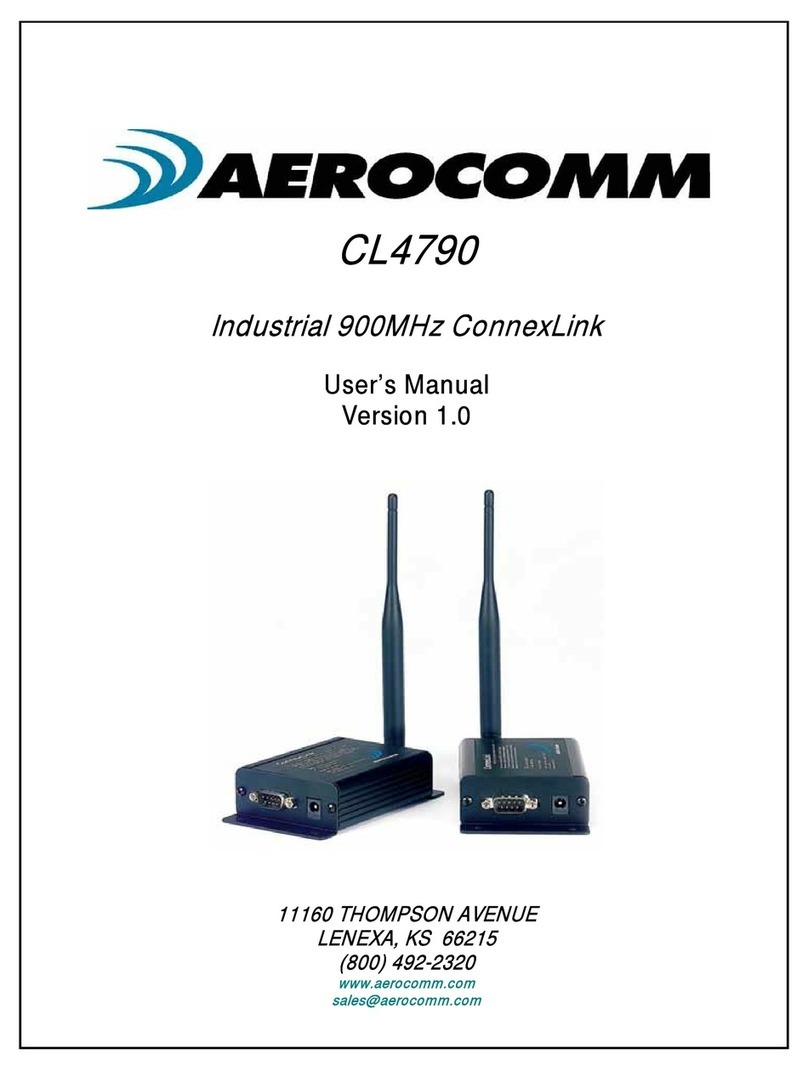
AeroComm
AeroComm CL4790 User manual

AeroComm
AeroComm CL4490PRO User manual
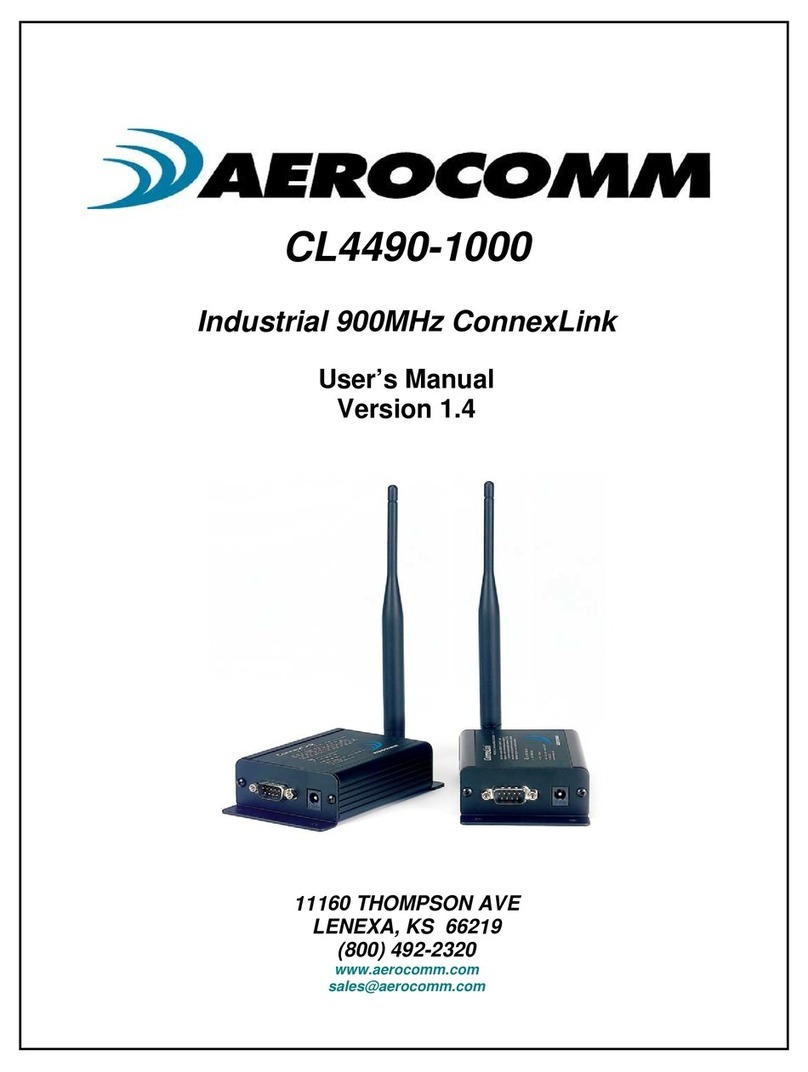
AeroComm
AeroComm CL4490-1000 User manual
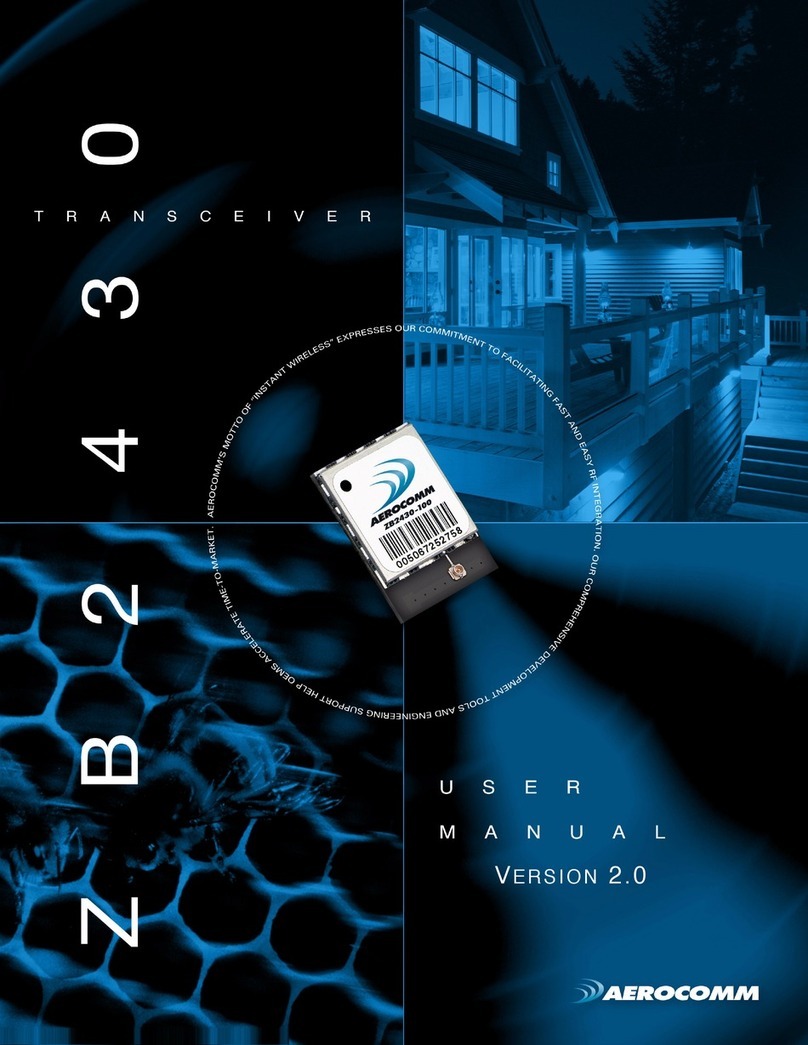
AeroComm
AeroComm TRANSCEIVER ZB2430 User manual
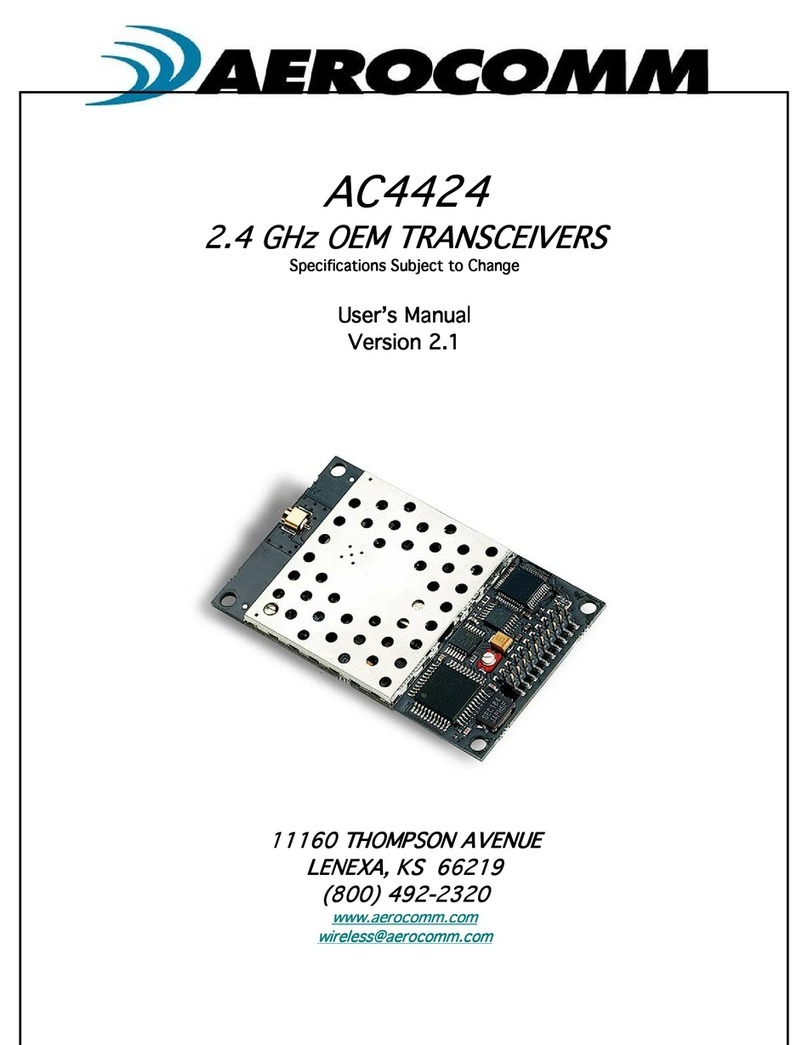
AeroComm
AeroComm AC4424 User manual
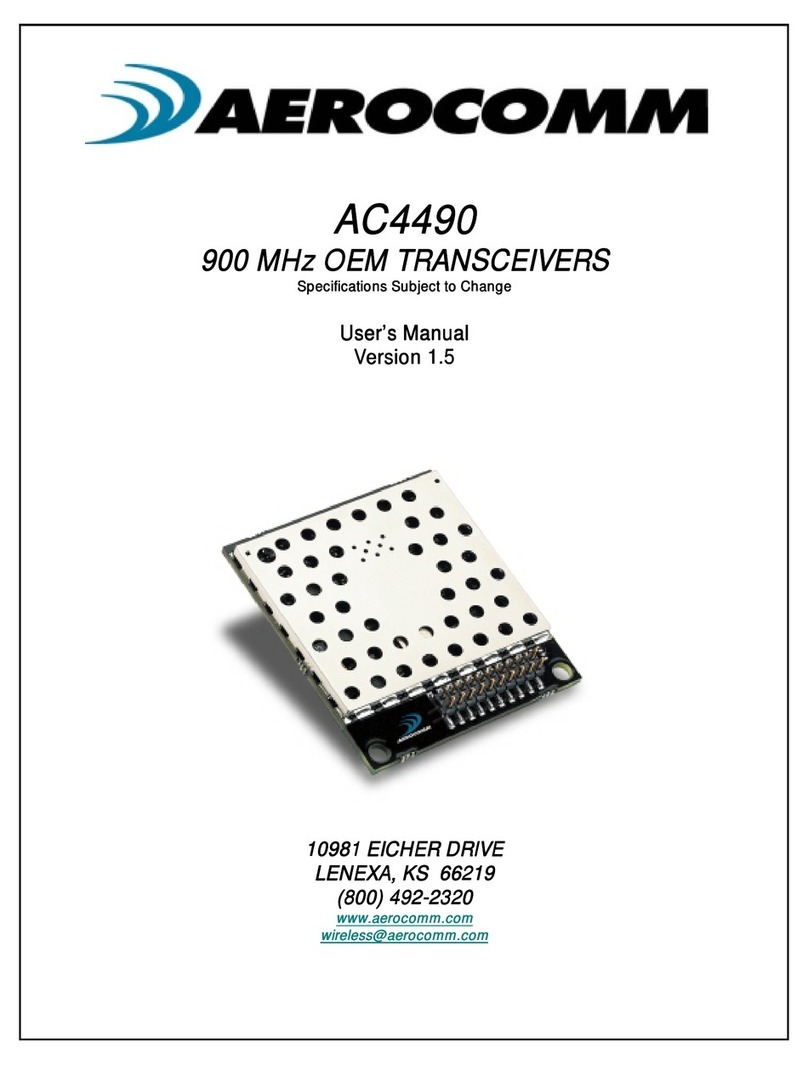
AeroComm
AeroComm AC4490 User manual
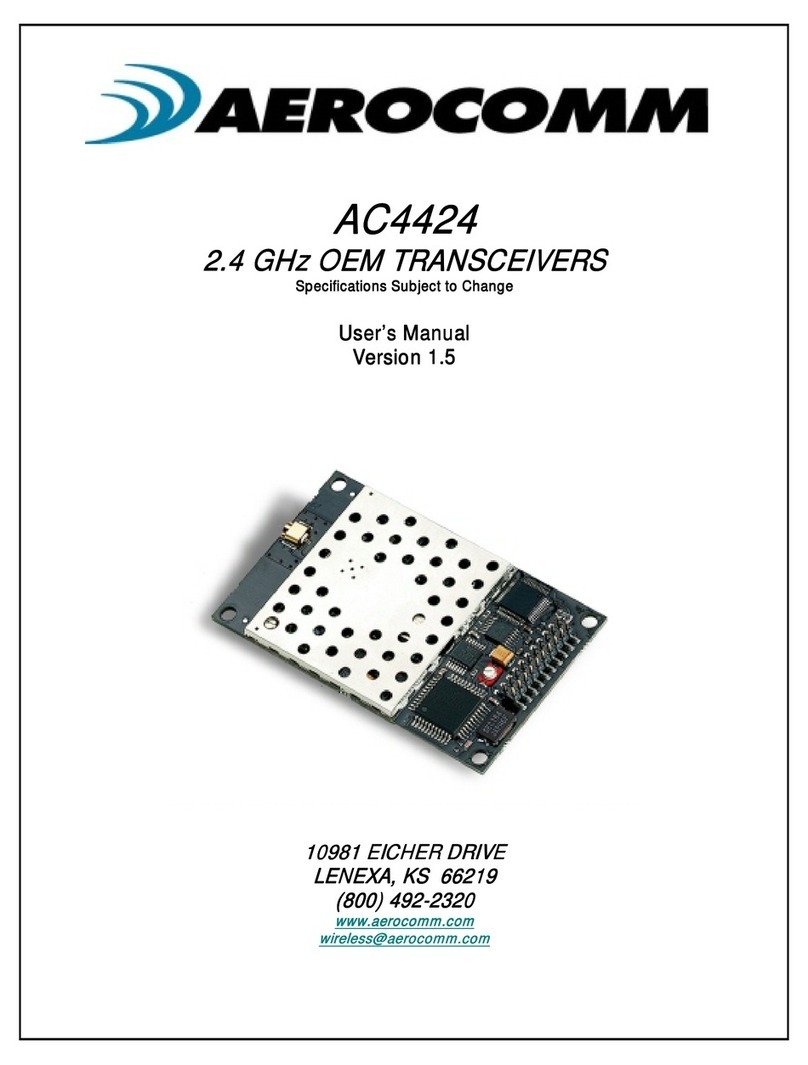
AeroComm
AeroComm AC4424-10 User manual
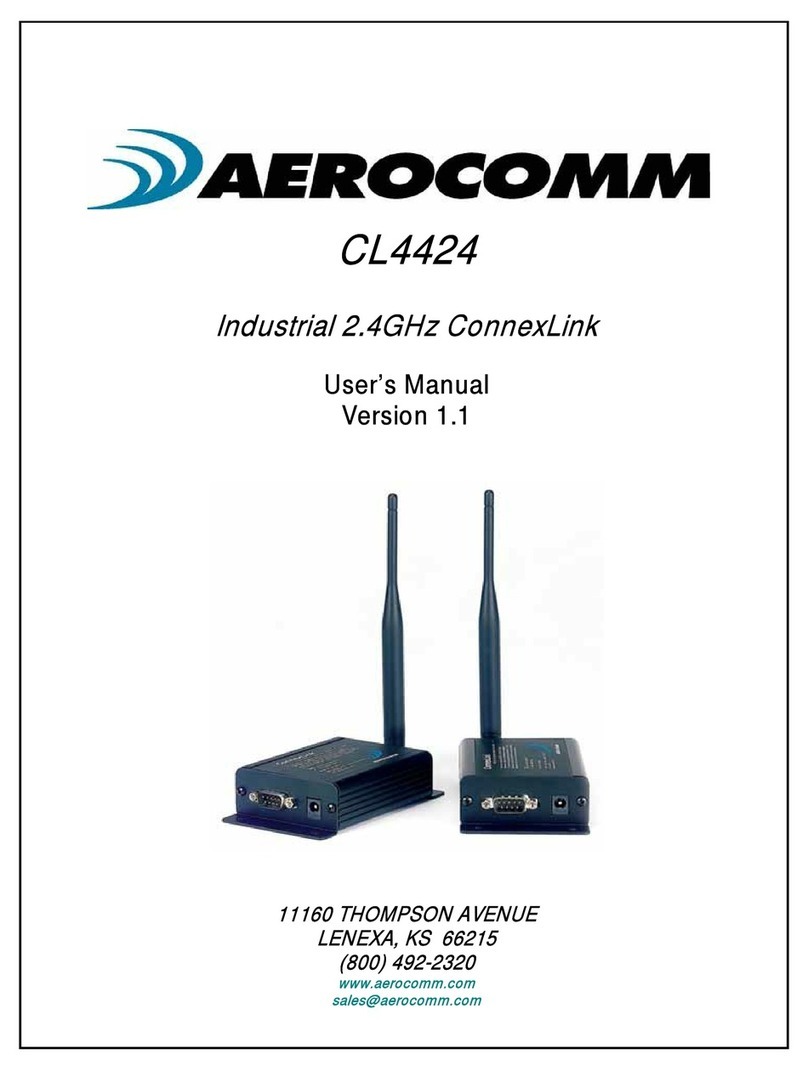
AeroComm
AeroComm CL4424 User manual
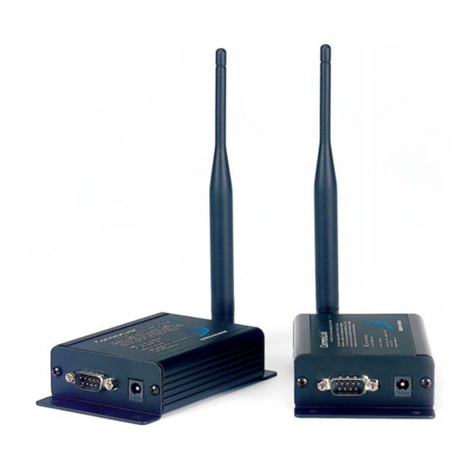
AeroComm
AeroComm CL4490-1000-485 User manual
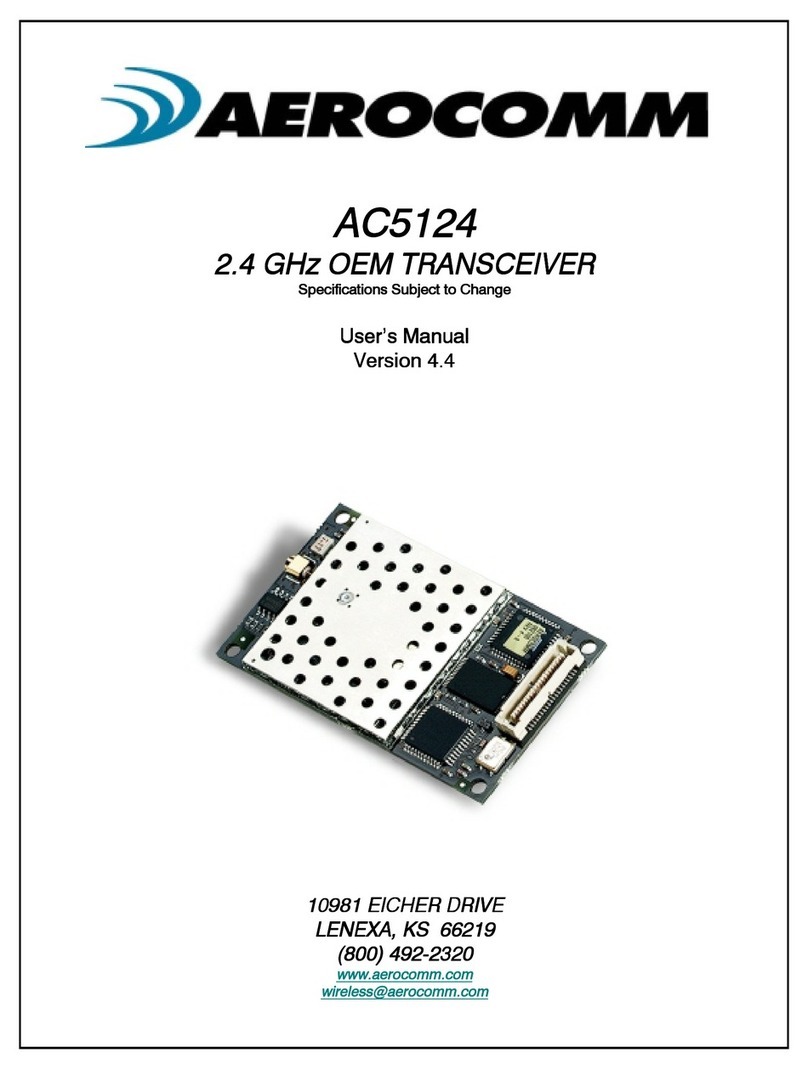
AeroComm
AeroComm AC5124 User manual



